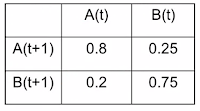Section 10 - Markov Models
States -
Transition Probabilities - chances of moving one state to another
Ex: Students who are Alert or Bored
There are some probabilities that student would transfer to the others
Simple Markov Model
Use student example above with20% of alert students become bored
25% of bored students become alert
Assume 100 alert and 0 bored ==> 20 become bored, 80 stay alert
equilibrium is difficult to calculate
Use a Markov Transition Matrices as follows:
After a number of period it reaches at equilibrium @ ~58%
Now we want to calculate what the values at equilbrium more directly. Here is what the calculation looks like. (NOTE - the step in the middle he is just multiplying everything by 20)
Markov Model of Democritization
Initial ExampleAssume democracies and dictatorships, where 5% of democracies becomes dictatorships, and 20% of dictatorships become democracies.
Model Involves Countries
Free, Not Free, Partly Free
Rules: 5% of free and 15% of not free become partly free, 5% of not free and 10% of partly become free, 10% of partly free become not free. Leaving the follow matrix
Markov Convergence Theorem
Tells us that, if the transition probabilities stay fixed, the systems will lead us to an equilibriumFour assumptions of Markov Processes
- Finite Number of States
- Fixed transition probabilities
- You can eventually get from any state to any other
- Not a simple cycle
- this says the initial state doesn't matter
- History doesn't matter either
- Intervening to change the state doesn't matter in the long run
Why would transitions probabilities need to stay fixed? Our interventions need to affect the transition properties in the right direction.




No comments:
Post a Comment